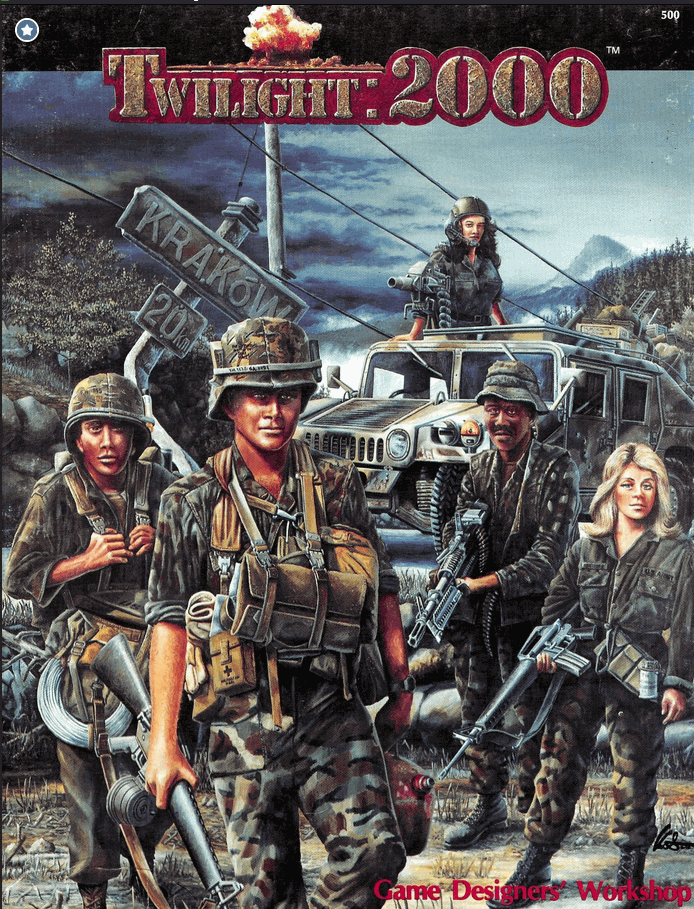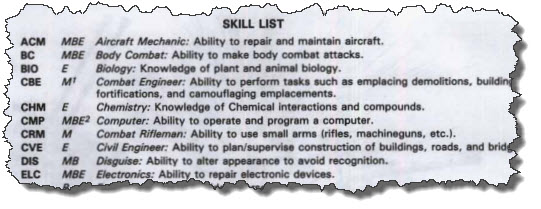Twilight 2000 Part 2
Twilight 2000
Part 2: New Moon
 When last we left our intrepid proto-tagonist (’cause he wasn’t done. Get it?), we… er… uhm… lemme reread that, I’ve been neck-deep in the fun kind of post-Apocalyptic game, with mutant humanoid rabbits and laser guns and sapient plants who produce explosive fruit they can throw (just added that one yesterday!).
When last we left our intrepid proto-tagonist (’cause he wasn’t done. Get it?), we… er… uhm… lemme reread that, I’ve been neck-deep in the fun kind of post-Apocalyptic game, with mutant humanoid rabbits and laser guns and sapient plants who produce explosive fruit they can throw (just added that one yesterday!).
Rereading…. (Whoa, I wrote about a game called “Twilight 2000” and I didn’t include a single (anachronistic for the game and way past its sell-by date for the time I’m writing it) joke about sparkly vampires? What the hell is wrong with me lately? In any event, I took care of that unforgivable oversight in the headings for this.)
Right! So, Nathan Tyler is (we hope… we’re about to see if we can build him close to the concept implied by the rolls) a techie type who probably expected to spend the war far away from the front lines, but ended up behind the ever-changing battle lines, until there were no more lines, just a no-man’s-land of rubble and survivors cut off from a home that may or may not still exist. He’s supposed to be qualified in disarmament, particularly of nukes, which makes him valuable enough for other, more combat-trained troops, to protect. I don’t anticipate him being completely useless in a fight, though. He’s at least average in Agility, which I will assume is the basis for shooting a gun. His biggest weakness is his Constitution.
Skills
Twilight 2000 uses a “task” mechanic, similar to that of other GDW games of the time, but with different… er… mechanics, as it’s percentile-based, not 2d6 based. The task can be Difficult (DIF), Average (AVG), or Easy (ESY) (Not EZ? Sigh.) The GM decides this, and also what skills or attributes are involved. You convert your 1-20 attributes to a percentage by multiplying by five. So my theory the 1-20 range was intended to map to a D20 may be wrong, or there may be other mechanics that do use that. (Addendum: No, there are not.)
Skills and Attributes are collectively called “Assets” for this section of the rules.
It’s a roll-under system on percentile dice. Easy tasks double the asset involved, Average tasks use it directly, Difficult tasks halve it. Simple enough. Most people can do the math involved mentally without effort, but you can also write down the calculations if you wish.
And, erm, all the Player’s Book does is say the above. The actual skills are in the GMs book, for some reason. Except… no, that’s just more details about defining tasks, such as setting different difficulties based on the skill being used, using the average of two assets to determine the base chance of a skill, or having more levels of difficulty than the three defaults. Wasn’t there some kind of “Player’s Charts” somewhere? Ah, yes. There it is, hidden under the sofa. In the basement. Behind the furnace. In the boarded-up room that used to be a speakeasy. Anyway, you get skill points based on multiplying your attributes.
- MEB x 40 points for military skills: 280.
- EDU x 20 points for Education skills: 280.
- 300 for Background skills.
I have basic scores in CRM, MC, BC, WVD, TW, and SWM. “What are those?” you ask. Well, flipping back a page, that’s Combat Rifleman, Melee Combat, Body Combat, ???, Thrown Weapon, and Swimming. Seriously. “WVD” isn’t on the chart. Since it’s in alphabetical order and TW is the last entry, I greatly suspect it just got cut off. Based on how the others are named, I am gonna guess it’s “Wheeled Vehicle Driving”, as that also makes sense for a skill everyone has some training in.

This Is All The Description You Get
My background also gives me NWH (Nuclear Weapon Handling) 50, and CBE (Combat Engineer) 50.
The second column in the chart, in italics, tells you which skill points each one uses: M(ilitary), B(ackground), and/or E(ducation). Buying a score over 50 costs double, unless it doesn’t. Many skills have footnotes explaining different rules for purchasing.These “stack” with modifiers from backgrounds. So, CBE (Combat Engineer) costs double (2 per point up to 50, 4 thereafter), but if you have the Combat Engineer specialty, you pay half cost — in other words, normal cost. Eastern Bloc soldiers can’t buy computer skill with background points, which probably made more sense in 1984. (There was an underground computer hobbyist scene in a lot of Soviet-era Eastern Europe, using mixes of smuggled Western computers and cobbled-together homebrews, but for obvious reasons, it wasn’t well known to the West until long after you couldn’t get shot for admitting to being part of it. But I digress.)
The relationship of attributes to skills is abstract, bordering on non-existent: Your attributes feed into your skill points, but investing 50 points in Hunting Bow gives you the same score (50) whether you have Agility 5 or 15. Also, the “multiply attribute by 5 if there’s no skill” mechanic leads to players trying to find ways to use their raw attributes, not their skills, if they happen to be fairly high. (This was often a factor in older games where the use of skills or proficiencies was sort of bolted on, often with “realistic” (that is, crappy) odds of success, but more generic attribute-based mechanics (even if not official) gave much higher chances. Without Actual Play experience, though, I can’t really say if this was a common tactic in T2K, or if it happened at all.)
Anyway, time to spend some points. Even though it costs double, I would like to kick up my CBE to at least 50. That’s 40 from military, leaving me 240.
CPM should be 60. That’s gonna be from Background, 70 points. That leaves… uh… 210, so I have 210 there, 240 military, and, uh…
Smeg it. I’m opening Excel now. (That’s how you know this is an old school game!)
(Jeopardy theme plays while I fiddle around with Excel until I like the results.)
OK, here’s the final tallies. You are allowed to spend points from multiple pools if the skill can be bought that way, so I spent both education and background points on Electronics (ELC)
| Skill | Rank |
|---|---|
| ACM (Aircraft Mechanic) | 50 |
| BC (Body Combat) | 40 |
| CBE (Combat Engineer) | 50 |
| CHM (Chemistry) | 20 |
| CMP (Computer) | 70 |
| CRM (Combat Rifleman) | 50 |
| CVE (Civil Engineer) | 50 |
| DIS (Disguise) | 30 |
| ELC (Electronics) | 75 |
| LP (Lockpick) | 40 |
| MC (Melee Combat) | 30 |
| MEC (Mechanic) | 80 |
| MNE (Mining Engineer) | 30 |
| NWH (Nuclear Warhead) | 70 |
| PST (Pistol) | 55 |
| SCR (Scrounging) | 60 |
| SWM (Swimming) | 50 |
| TW (Throw Weapon) | 30 |
| WVD (Wheeled Vehicle Driving) | 60 |
So, I will say this: You do get enough skill points to round out a character to match a concept. Granted, for “Difficult” rolls, most of my odds are pretty low, but for many skills, I will make “Easy” checks automatically and have good odds for “Average” checks. I could have gone for fewer, higher, skills, but I like breadth over depth.
The Hits Keep On Missing
I now have to calculate my “Base Hit Numbers”. Did you think it was just “Well, you roll under your appropriate skill, right?” You fool! You foolish fool! This is OLD SCHOOL! Any given value can be, and probably is, the input into a formula, and the output from that formula becomes an input to another in turn! (Hey, it was this realization that led Charles Babbage to understand how his “Difference Engine” could become an “Analytical Engine” by “eating its own tail” — taking the results of calculations and using them for further operations.)
Anyway, close hit is skill x 0.6, medium is 0.3, and long is 0.1. Given my skills, that means:
CRM: 30, 15, 4
PST: 33, 16, 5
(I have no skill ranks in the other three combat skills — Heavy Weapons (HW), Large Caliber Guns (LCG), and Hunting Bow (HB). Thrown Weapons (TW) doesn’t use these rules. Because of course. Instead, it increases the difficulty for longer ranges, which makes perfect sense, and I’m not sure why the other ranged combat skills didn’t follow suit.)
Body Combat Damage is ((Strength(12) + Stature(13)) x Body Combat Skill) /200 =5. I do 5 +1d6 damage in “Body Combat”.
Melee Combat, for the record, works as you might expect: You make an average check against your MC skill; if appropriately armed, an enemy may make a block (MC:DIF), which will negate your attack.
And In Conclusion
That’s really about it for T2K in terms of chargen. I could discuss combat and other mechanics, but that’s never really been the focus of these articles. There’s equipment buying, too, but it’s more of a group activity — quite reasonable, as you are assembling a Band of Broth Siblings who will likely share a main vehicle, supplies, ammo, and so on.
That I was able, more-or-less, to start with a handful of random rolls, turn them into a concept, then build the mechanical support (skills) needed for that concept is a definite “win” for the system. While that may seem the lowest possible bar, a lot of games then… and even quite a few now… fail to “do what they say on the tin” in terms of lining up character concept with character mechanics. “Just roleplay it!” or “The GM will let you ignore that” are not answers. If I want to just “tell a story”, I can do that without a rulebook, thankyouverymuch.
There’s no denying the game was a huge success at the time, spawning literally dozens of supplements and attracting a loyal fan base and probably creating a lot of memories still beloved by the players.
On the downside, the rules organization is a mess. Or, at least, having the rules in a single non-bookmarked PDF is a mess. If I had the actual boxed set where I had the player book open and the player reference sheets lying next to them, figuring out where things were would have been easier. This could have been accomplished by producing a set of PDFs where each of the books and booklets were in their own file, and by adding appropriate indexing. It’s sad when pirates copying games put more effort into their production values than the actual rights-holders do.

Comments
Twilight 2000 Part 2 — No Comments
HTML tags allowed in your comment: <a href="" title=""> <abbr title=""> <acronym title=""> <b> <blockquote cite=""> <cite> <code> <del datetime=""> <em> <i> <q cite=""> <s> <strike> <strong>